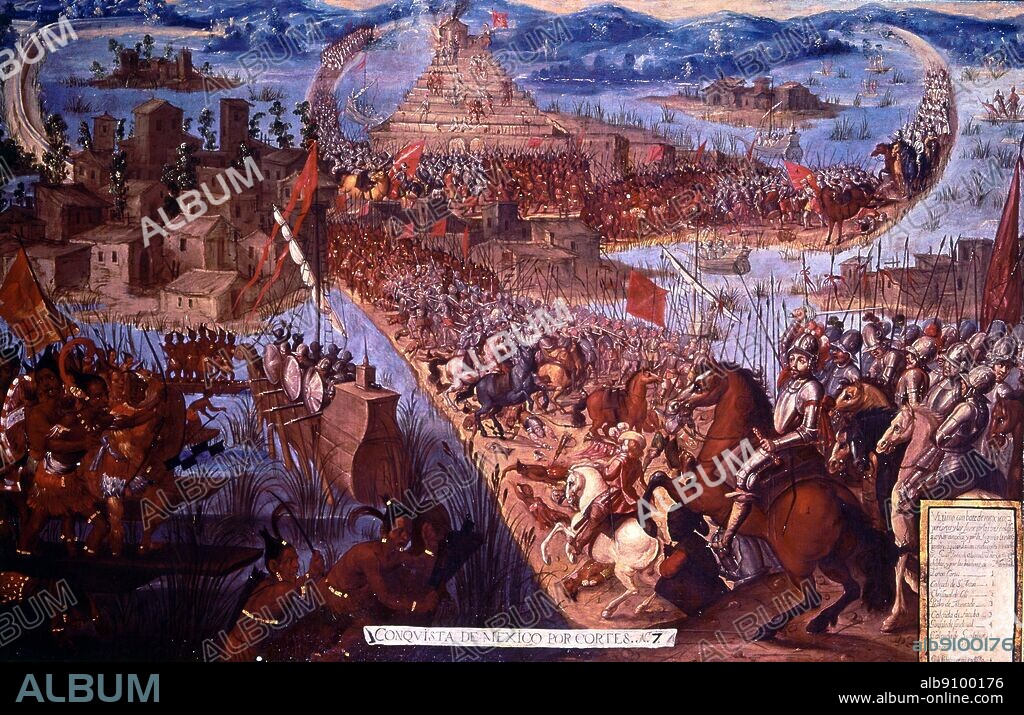alb9100176
The Conquest of Tenochtitlán, unknown artist, from The Conquistadors by Hammond Innes, page 142 . The painting shows the conquest of Tenochtitlán (now the site of Mexico City). The battle between the Spanish under Hernán(do) Cortés, marqués del Valle de Oaxaca (1484-1547) and the Mexica under the last Aztec leader Cuauhtémoc (c.1502-1525) is more properly called a siege. It began in May of 1521 and lasted into August. With newly built ships, the Spanish controlled the lake surrounding the island and blockaded the city. Ultimately Cortés ordered the complete destruction of Tenochtitlán, including its palaces, temples and squares. Cortés led his Spanish armies across one of the causeways and into the city. The captains of the other parts of his army also led their troops towards the centre of the city and the main temple compound. The Mexica put up a spirited and skilled resistance, but by August they could no longer defend the city. The surrender of the survivors, the destruction of the main temple and the capture of Cuauhtémoc marked both the end of the battle for Tenochtitlán and the end of Aztec Empire.

|
Añadir a otro lightbox |
|
Añadir a otro lightbox |



¿Ya tienes cuenta? Iniciar sesión
¿No tienes cuenta? Regístrate
Compra esta imagen.
Selecciona el uso:

Título:
The Conquest of Tenochtitlán, unknown artist, from The Conquistadors by Hammond Innes, page 142 . The painting shows the conquest of Tenochtitlán (now the site of Mexico City). The battle between the Spanish under Hernán(do) Cortés, marqués del Valle de Oaxaca (1484-1547) and the Mexica under the last Aztec leader Cuauhtémoc (c.1502-1525) is more properly called a siege. It began in May of 1521 and lasted into August. With newly built ships, the Spanish controlled the lake surrounding the island and blockaded the city. Ultimately Cortés ordered the complete destruction of Tenochtitlán, including its palaces, temples and squares. Cortés led his Spanish armies across one of the causeways and into the city. The captains of the other parts of his army also led their troops towards the centre of the city and the main temple compound. The Mexica put up a spirited and skilled resistance, but by August they could no longer defend the city. The surrender of the survivors, the destruction of the main temple and the capture of Cuauhtémoc marked both the end of the battle for Tenochtitlán and the end of Aztec Empire.
Descripción:
Traducción automática: La Conquista de Tenochtitlán, artista desconocido, de Los conquistadores de Hammond Innes, página 142. La pintura muestra la conquista de Tenochtitlán (ahora el sitio de la Ciudad de México). La batalla entre los españoles bajo Hernán(do) Cortés, marqués del Valle de Oaxaca (1484-1547) y los mexicas bajo el último líder azteca Cuauhtémoc (c.1502-1525) se llama más propiamente asedio. Comenzó en mayo de 1521 y duró hasta agosto. Con barcos recién construidos, los españoles controlaron el lago que rodeaba la isla y bloquearon la ciudad. Al final, Cortés ordenó la destrucción completa de Tenochtitlán, incluidos sus palacios, templos y plazas. Cortés condujo a sus ejércitos españoles a través de una de las calzadas y entró en la ciudad. Los capitanes de las otras partes de su ejército también condujeron sus tropas hacia el centro de la ciudad y el recinto principal del templo. Los mexicas opusieron una resistencia enérgica y hábil, pero en agosto ya no podían defender la ciudad. La rendición de los supervivientes, la destrucción del templo principal y la captura de Cuauhtémoc marcaron tanto el final de la batalla por Tenochtitlán como el fin del Imperio Azteca.
The Conquest of Tenochtitlán, unknown artist, from The Conquistadors by Hammond Innes, page 142 . The painting shows the conquest of Tenochtitlán (now the site of Mexico City). The battle between the Spanish under Hernán(do) Cortés, marqués del Valle de Oaxaca (1484-1547) and the Mexica under the last Aztec leader Cuauhtémoc (c.1502-1525) is more properly called a siege. It began in May of 1521 and lasted into August. With newly built ships, the Spanish controlled the lake surrounding the island and blockaded the city. Ultimately Cortés ordered the complete destruction of Tenochtitlán, including its palaces, temples and squares. Cortés led his Spanish armies across one of the causeways and into the city. The captains of the other parts of his army also led their troops towards the centre of the city and the main temple compound. The Mexica put up a spirited and skilled resistance, but by August they could no longer defend the city. The surrender of the survivors, the destruction of the main temple and the capture of Cuauhtémoc marked both the end of the battle for Tenochtitlán and the end of Aztec Empire.
Crédito:
Album / TopFoto
Autorizaciones:
Modelo: No - Propiedad: No
¿Preguntas relacionadas con los derechos?
¿Preguntas relacionadas con los derechos?
Tamaño imagen:
3738 x 2415 px | 25.8 MB
Tamaño impresión:
31.6 x 20.4 cm | 12.5 x 8.1 in (300 dpi)
Palabras clave:
AGRACIADO • AMERICA LATINA • AMERICA • ASEDIO • ATAQUE • BARCO • BATALLA • BATALLAS • BOTES (BARCOS) • CABALLO • CABALLOS • CIUDAD • CONFLICTO BELICO • CONQUISTADOR • CONTINENTE AMERICANO • CRUZADO • CUAUHTEMOC • DEFENSA • EJERCITO • EMPERADOR AZTECA • ESPANA • ESPANOL • ESPAÑA • EUROPEA • EUROPEAS • EUROPEO • EUROPEOS • EXPLORACION • GENTE • GUERRA • IBEROAMERICANA • ISLA • LAGO • LATINOAMERICA • LATINOAMERICANA • LATINOAMERICANO / A • LATINOAMERICANO • SIGLO XVI • SOBERANO AZTECA • SOLDADO • SOLDADOS • TEMPLO • TENOCHTITLAN • VICTORIA • WAR
 Pinterest
Pinterest Twitter
Twitter Facebook
Facebook Copiar enlace
Copiar enlace Email
Email
